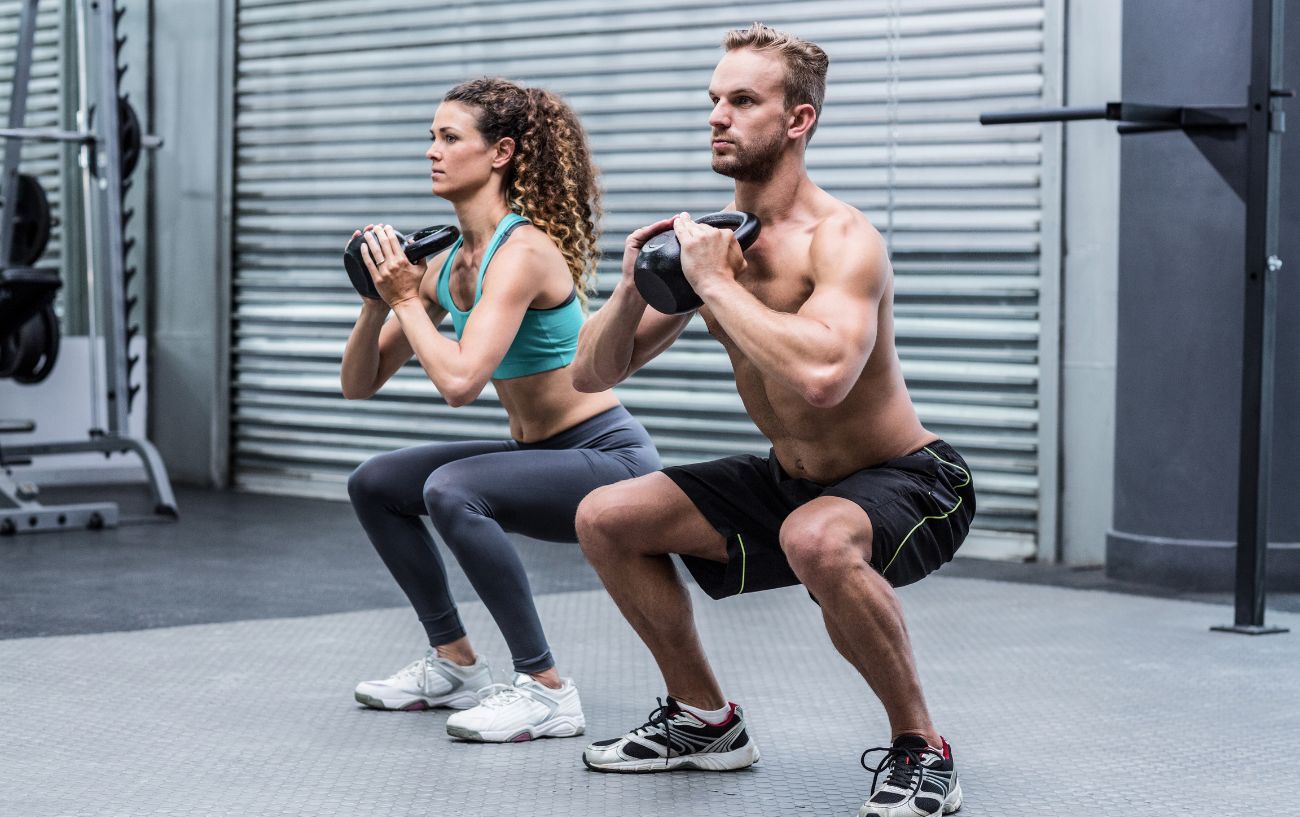Although the keto diet is a popular approach to weight loss and improved health, understanding how to combine keto and exercise can be challenging.
The lack of carbohydrates allowed on the keto diet can make working out on keto difficult for those who want to do high-intensity exercise for endurance activities like marathon training, and some studies have found that ketosis impairs exercise economy.
So, is it possible to do exercise on keto successfully?
In this keto and exercise guide, we will discuss the challenges of working out on keto, tips for keto and weight training or other types of exercise, and how to combine keto and working out for weight loss and performance.
We will look at:
- Can You Work Out On Keto?
- Keto and Exercise: 6 Tips for Working Out On Keto
Let’s get started!

Can You Work Out On Keto?
Getting regular exercise is important for overall health.
Whether or not you are doing keto for weight loss, finding a way to combine keto and exercise will be an important step in your overall health and wellness routine if you plan to follow the keto diet for any extended period of time.
While it is certainly possible to do keto and weight training or to combine keto and working out in general, there are definite challenges to exercising on the keto diet, mainly due to the fact that the keto diet limits total carbohydrate intake to roughly 20 to 50 grams per day at most.
Although the body can adapt to burning fat at higher intensities of exercise—and some studies show ketosis may even improve performance—the muscles generally prefer to burn glycogen and glucose (stored carbohydrates and circulating blood sugar) during vigorous exercise.
This is because when carbohydrates are oxidized for energy (ATP), the metabolic process to yield this ATP is much faster than when trying to burn triglycerides, which are stored fat molecules.

Therefore, in order to keep pace with the energy demand from the muscles during high-intensity exercise, burning carbohydrates is a better option because energy can be created faster than when burning fat for fuel.
For this reason, weightlifting on keto, high-intensity interval training or HIIT workouts on keto, running on keto, and other vigorous exercise on keto can be difficult, particularly when you first switch to the keto diet.
However, by timing your carb intake and implementing some additional tips and strategies to help support exercising on keto, you can help optimize working out on keto in ways that may even reduce muscle breakdown.
Overall, the takeaway should be that you can absolutely combine keto and working out, and you should exercise on the keto diet, or any diet for that matter.
Keto and Exercise: 6 Tips for Working Out On Keto
Especially if you are lifting weights on keto, doing HIIT on keto, or combining some other type of vigorous exercise with the keto diet, it is helpful to incorporate some of the following tips to support keto and exercise:

#1: Time Your Carb Intake
Although the keto diet is a very low-carb diet, it is not a no-carb diet.
This means that you can use the limited keto carbs you have to your advantage when timing exercise on the keto diet.
Having carbs right before and after your workout is the best way to fuel your body for high-intensity exercise and help replenish blood sugar and a little bit of glycogen after your workouts.
Keto experts suggest that the keto diet should involve consuming 70–75% of your calories from fat, 20-25% of your calories from protein, and 5% of your calories from carbohydrates, or limiting carbohydrate intake to 50 grams of total carbs per day or 20 to 30 grams of net carbs per day (total carbs minus the grams of fiber).
If you are having 50 grams of carbs on keto every day, you could have 25-30 grams of carbs 30-60 minutes before you exercise and 20 grams immediately afterward (or during, depending on the duration and intensity of your workout).
Although this is far less than what is typically recommended for fueling for athletes, it is one way to help facilitate working out on keto with minimal carb intake.

#2: Progress Gradually
Whether you start with the keto diet and then begin incorporating exercise into your life, or you have been a long-time athlete and are transitioning to the keto diet, start combining exercise and keto slowly.
If you have been consistently following keto and want to start working out, begin with short, low-intensity workouts so that your body can adjust to the energy output of more physical activity.
On the other hand, if you are an active individual who has decided to try the keto diet, cut back on your workouts or make sure to transition gradually to keto by slowly cutting back your carbs over the course of 1 to 2 weeks until you are fully following the keto diet.
#3: Hydrate Well and Have Electrolytes
One of the main causes of the keto flu—a common condition experienced when one first starts the keto diet—is dehydration and electrolyte depletion.
Because the keto diet is extremely low in carbohydrates, the body sheds excess water very quickly.

Electrolytes are also lost in the increased excretion of urine, and if you are cutting out fruits, legumes, whole grains, and vegetables, you will also be decreasing your intake of natural electrolytes.
This will further leave you feeling depleted, and when sodium levels drop, your body releases even more water weight.
Dehydration of just 2% of your body weight can impact athletic performance, and dehydration of less than that can cause feelings of fatigue, difficulty concentrating, low energy, and dizziness, all of which can negatively impact your ability to work out on keto.
Make sure that you are hydrating even more than you think you need to, and emphasize electrolytes by adding a keto-friendly electrolyte powder or electrolyte tablet to your fluids.
We love Ultima Replenisher Electrolyte Hydration Powder for keto athletes.
This keto-friendly, gluten-free, vegan, non-GMO, sugar-free electrolyte powder contains zero calories and zero junk.
Plus, unlike most keto electrolyte powders and keto sports drinks, Ultima Hydration does not have sugar alcohols, which can upset your stomach and really aren’t good for your body.

#4: Consider Keto Breaks
If you are a competitive athlete on keto, consider taking breaks from keto around competitions, especially if you are an endurance athlete such as a marathoner or triathlete.
The night before a long run or the morning of, consider switching off keto and having enough carbs before and during your workouts to support performance and recovery.
Follow the same practice for races.
You will need to decide whether you want to prioritize the keto diet or your athletic performance, but there are no “rules“ that say you have to do keto seven days a week.
#5: Try MCT Oil
Particularly if you are doing keto and weight training or HIIT workouts, consider taking MCT oil or MCT powder before and during your workouts to fuel your keto workouts.
MCT oil supplements can provide a quick-acting source of energy because the chemical structure of medium-chain triglycerides bypasses much of the normal digestive steps for fats, allowing you to get a readily-available source of energy.
Using MCT powder when weightlifting on keto during your workouts can potentially help substitute for the lack of carbs and the ability to take in glucose when doing keto workouts while still providing some fast-acting energy compared to long-chain triglycerides from most fats on the keto diet, which take a long time to digest.
As a bonus, MCT oil may also promote satiety, helping control appetite and potentially support weight loss.

#6: Be Patient
Working out a keto is physiologically more difficult.
The good news is that studies show the body will adapt to become better at oxidizing fat for fuel when exercising on keto and that ketosis may actually improve endurance.
However, this process takes time, and your ability to work out at higher intensities during this adaptation process will be compromised.
Be patient with yourself and your body and scale back as needed or adjust your expectations.
Above all, when considering working out on keto, you have to listen to your body.
If you are just not feeling well exercising on keto, you may need to reconsider your diet choice and potentially choose an alternative low-carb diet such as the Atkins diet or the Paleo diet, or even something a little bit more balanced such as the 40-40-20 diet.
You can learn more about the keto diet vs Paleo diet here.







